1. Introduction
 Connect3D is a manufacturer of graphics cards for the PC industry and a long time certified partner of ATI. From the Radeon 7000 to the latest X850 cards, Connect3D has always been present with competitive prices, top-notch products and excellent support.
Connect3D is a manufacturer of graphics cards for the PC industry and a long time certified partner of ATI. From the Radeon 7000 to the latest X850 cards, Connect3D has always been present with competitive prices, top-notch products and excellent support.
The X300SE belongs to the lower-price range cards from ATi's latest "X" generation. Its price is around US$60 which makes it appealing to most low-end users. The card comes in three flavours, 64MB, 128MB and a Hypermemory model with support for up to 256MB. The card we'll be testing in this review is the Connect3D X300SE model that features 128MB of physical memory.
- Packaging/Bundle
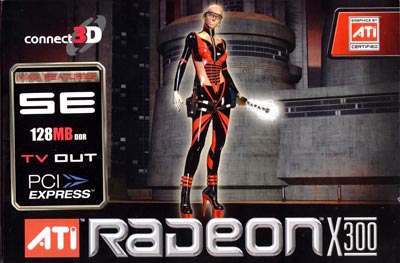
The card ships in the smallest of boxes, barely large enough to hold the card and it's accompaniment of accessories. Once again we'd like to remind you that Connect3D bundles no games along with their cards, in an attempt to keep the total end-cost as low as possible.
Of course, inside the package you'll still find a CD containing the card's drivers, a printed "Getting started" guide to help you install the card and an S-Video to composite cable adaptor.
2. Features
| Main Features |
| GPU |
ATi Radeon X300 - RV370 |
| Memory Brand/Model |
Elixir N2D525616CT-5T (5ns) |
| Memory Type |
128 MB 64-bit SDRAM |
| Engine Clock Speed |
325MHz |
| Memory Clock Speed |
195MHz (390MHz effective) |
| Memory Bandwidth |
3.1 GB/sec |
| Pixel Pipelines |
4 |
| Vertex Units |
2 |
| Fill rate |
1.3 Giga pixels /sec |
| DX Support |
9.0 |
| OpenGL Support |
1.5 |
| Output |
VGA / DVI-I / S-Video |
| Bus |
PCI-Express 16X |
| Processing technology |
0.11 micron |
The X300SE is based on the RV370 processor from ATi. The RV370 architecture utilises 4 pixel pipelines which is no real progress from the older generation 9200SE, as well as 2 vertex units, one more than the 9200SE.
This RV370 chipset is of course, PCI-Express-native and just like all X300 and X600 based cards, there are no plans for AGP versions of the card.
These are the specs as reported by ATITool:
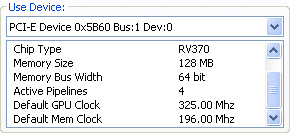
As you can see, the memory bus is only 64-bits wide. Along with the really slow 5ns memories, this is going to hold back the card's performance.
SmartShader™ 2.0
-SmartShader™ defines the level of realism in latest 2D/3D games and applications
-Complete hardware-accelerated Microsoft® DirectX® 9.0 programmable vertex and pixel shader support
-Full hardware support for OpenGL®
SmoothVision™ 2.1
-SmoothVision™ improves image quality by smoothing jagged edges, improving blurriness and refining background details during on-screen motion and at lower resolutions.
-SmoothVision™ settings are user configurable in ATI Catalyst™ Control Panel:
2x/4x/6x Anti-Aliasing modes
-Sparse multi-sample algorithm with gamma correction, programmable sample patterns, and centroid sampling
-Lossless Color Compression (up to6:1)at all resolutions
-Temporal Anti-Aliasing
-2x/4x/8x/16x Anisotropic Filtering modes
-Up to 128-tap texture filtering
-Adaptive algorithm with bilinear (performance) and trilinear (quality) options
HYPER Z™ III
-HyperZ™ ensures optimal hardware performance by discarding irrelevant object data that is not visible to end-user on their display.
-Leverages key features from ATI’s third generation HyperZ™ III technology that conserves video memory bandwidth for improved performance in demanding 2D/3D games and applications.
-Lossless Z-Buffer Compression (up to 48:1)
-Fast Z-Buffer Clear
Z Cache optimized for real-time shadow rendering
VideoShader™
-Seamless integration of pixel shaders with video in real time
-FullStream™ video de-blocking technology for Real, DivX, and WMV9 formats
-VideoSoap™ noise removal filtering for captured video
-MPEG1/2/4 decode and encode acceleration
-DXVA Support
-Hardware Motion Compensation, iDCT, DCT and color space conversion
-All-format DTV/HDTV decoding
-YPrPb component output for direct drive of HDTV displays†
-Adaptive Per-Pixel De-Interlacing and Frame Rate Conversion (temporal filtering)
Additional Features
-Dual integrated display controllers
-Dual integrated 10 bit per channel 400 MHz DACs
-Integrated 165 MHz TMDS transmitter (DVI 1.0 compliant / HDMI interoperable and HDCP ready)
-Integrated TV Output support up to 1024x768 resolution
-Windows® Logo Program compliant
-ATI Catalyst™ Software Suite
3. A closer look
The Connect3D X300SE is a "simple" design card on a bright red PCB.
 |
| The front side of the card.(click for hi-res). |
An aluminium heatsink is responsible for keeping the GPU's temperature at a minimum level. The heatsink, although overlapping two of the memory modules located on the board, does not actually make contact with them in order to cool them as well.
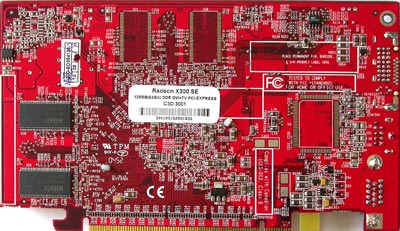 |
| The rear side of the card (click for hi-res) |
 |
| The RV370 chipset powering the X300SE |
Speaking of memory, the card is equipped with 4 x N2D525616CT-5T (5.0 ns) modules from Elixir. Each module provides the card with 32MB, resulting in a total 128MB. The memory parts are split into two sets of two, one set on each side of the card.
 |
| Elixir N2D525616CT-5T |
As usual, the card's output consists of one standard VGA, one DVI-I and an S-Video output. Using the included S-Video to composite cable you can connect the card with a TV for video playback.


4. Test System
Processor: AMD 3500+
Case: Antec 1080AMG
Motherboard: Abit FATAL1TY AN8
Memory: 2x512MB OCZ PC-4200 Memory
Hard Disk Drive: WD800JD 80GB 7200RPM
CD-RW: LiteOn LTR-52246S
PowerSupply: Levicom 500Watt
Microsoft WindowsXP Pro SP2
DirectX v9.0c

Benchmarking Software
3DMark05,03,01
Codecreatures Benchmark Pro
AquaMark3 v3.0
ATiTool 0.0.23
Farcry v1.3
CounterStrike Source
Doom 3
Thief 3
Ground Control II
Colin McRae '05

5. 3DMark05
 With 3DMark05, Futuremark continues the tradition in its benchmarking software by providing a state-of-the-art Microsoft ® DirectX ® 9 3D performance benchmark.
3DMark05 is an all new 3DMark version making the most of Microsoft's DirectX
9. The previous version 3DMark03, did a nice introduction into this level
of technology. However
3DMark03 used DirectX 9 specific features in a limited manner, because fully
supporting hardware was rare at the time of its launch. In contrast, 3DMark05
requires DirectX 9 hardware with full support for at least Shader Model 2,
and takes shader usage to never before seen levels.
Just like its predecessors, 3DMark05's point system is set so that at the
moment of release, the high-end VGA cards available in stores can only score
around 5000 3DMarks, whereas the worst card that meets the programs requirements
yields a score of 1000.
With 3DMark05, Futuremark continues the tradition in its benchmarking software by providing a state-of-the-art Microsoft ® DirectX ® 9 3D performance benchmark.
3DMark05 is an all new 3DMark version making the most of Microsoft's DirectX
9. The previous version 3DMark03, did a nice introduction into this level
of technology. However
3DMark03 used DirectX 9 specific features in a limited manner, because fully
supporting hardware was rare at the time of its launch. In contrast, 3DMark05
requires DirectX 9 hardware with full support for at least Shader Model 2,
and takes shader usage to never before seen levels.
Just like its predecessors, 3DMark05's point system is set so that at the
moment of release, the high-end VGA cards available in stores can only score
around 5000 3DMarks, whereas the worst card that meets the programs requirements
yields a score of 1000.
Game Test 1 - Return to Proxycon
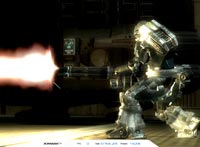 Being the sequel to the "Battle of Proxycon"
from 3DMark03, in "Return to Proxycon" we're once again set in space
and the battle continues as space pirates invade a cargo ship in order to
take control of its valuable cargo.
Being the sequel to the "Battle of Proxycon"
from 3DMark03, in "Return to Proxycon" we're once again set in space
and the battle continues as space pirates invade a cargo ship in order to
take control of its valuable cargo.
This test, tries to simulate a future first-person shooter game with all the high details that entails. The dynamic shadows, high-detailed environment and advanced lighting techniques ensure that under normal circumstances, no recent card can run it with decent frame rates.
Game Test 2 - Firefly Forest
 A forest gets filled with magic fireflies in the night. The moon is nearly full, illuminating the forest with a bluish faint light. The magic fireflies have flickering bright green lights that playfully move around the forest.
A forest gets filled with magic fireflies in the night. The moon is nearly full, illuminating the forest with a bluish faint light. The magic fireflies have flickering bright green lights that playfully move around the forest.
This scene is a nice example of a smaller scale outdoor scene with rich vegetation. Immediate visibility is not so far, and there is a skybox surrounding the whole scene.
A large number of trees with their branches swinging separately, and dense vegetation being dynamically distributed according to the camera movements, make this test the most demanding of the three.
Game Test 3 - Canyon Flight
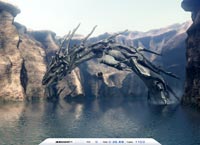 A Jules Verne type airship flies through a canyon guarded
by a dangerous sea monster. The airmen defend their ship using heavy cannons,
but these seem to have no effect on the huge sea monster. Finally the crew
manages a narrow escape using the "last resort" afterburners of
the airship.
A Jules Verne type airship flies through a canyon guarded
by a dangerous sea monster. The airmen defend their ship using heavy cannons,
but these seem to have no effect on the huge sea monster. Finally the crew
manages a narrow escape using the "last resort" afterburners of
the airship.
This scene is fairly complex with large areas of water
reflecting the high canyon walls. The water actually is one of the key points
of interest in this scene. The water not only does realistic looking reflections
and refractions, it has a depth fog, making the sea monster swimming under
the airship actually look deep down in the water. The air in this scene also
uses a volumetric fog, making distant cliffs of the canyon really look far
away.

The Connect3D X300SE had the lowest framerate in GT1 and GT3 but then topped the two other cards in GT2. However, none of these cards is really supposed to run such graphically intensive games as the 3DMark05 game tests which explains the really low frames per second rates.
Final Score
3DMarks on 3DMark05 are now calculated by the following formula:
(Game Test 1 * Game Test 2 * Game Test 3)^0.33 * 250
This is basically the geometric mean of the total frames in each
game multiplied by 250. This means that all game tests are now equal.

Don't be surprised by the really low scores. As Futuremark has determined, most low-end graphics cards would yield around 1000 3dmarks in this benchmark.
6. 3DMark03
 3D Mark is a widely used and accepted benchmark that stresses the DirectX performance of a VGA card. A very strong point of 3DMark is that it's VGA card measuring is does not require any CPU power. So the resulting fps are a good reference a VGA card's rendering performance. For testing the performance of each card we used the 4 game benchmarks 3DMark has.
3D Mark is a widely used and accepted benchmark that stresses the DirectX performance of a VGA card. A very strong point of 3DMark is that it's VGA card measuring is does not require any CPU power. So the resulting fps are a good reference a VGA card's rendering performance. For testing the performance of each card we used the 4 game benchmarks 3DMark has.
3Dmark03 also includes sound and CPU tests as well as some other feature tests.
- Game Test 1 - Wings of Fury (DX7)

This test is a combat flight simulator written for older hardware (DirectX 7). Particles are used a lot in this test - smoke and vapor trails, flak and gunfire, and explosions are produced using point sprites and quads.
- Game Test 2 - Battle of Proxycon (DX8)

This test is a simulation of first person shooter game types. 1.1 and 1.4 Vertex shaders are widely used since all character models are skinned using vertex shaders.This makes this test a good vertex shader comparison for VGA cards.
- Game Test 3 - Trolls' Lair (DX8)

This test should be the favorite of all RPG lovers. It is a cut scene of a female warrior facing two malicious trolls. Again the same vertex and pixel processing is used as in game test 2.
This test also uses post-processing effects, such as Depth of Field and Bloom effects which are widely used in today's game cut scene sequences.
- Game Test 4 - Mother Nature (DX9)

Mother nature represents the level of effects and realism that are possible using 2.0 vertex and pixel shaders, plus some other features that DirectX 9 offers.
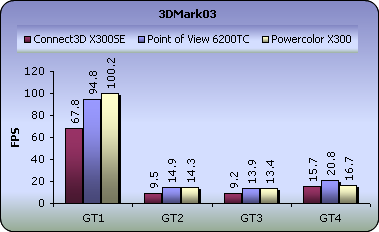
3DMark03 is a little lighter than its successor but still not light enough for the X300SE. Even in the DX7 based GT1 test, its score is very low compared to that of the 6200TC or X300.
- 3DMark Official score
If you test your machine with 3DMark, you can post the results at 3DMark's online result browser. For more information visit futuremark.com.

We can see now that the 3DMark05 scores did not reflect the true differences. The scores were so low that the differences between them were too small so as to be able to come to any conclusion. In this benchmark, the X300SE is at 70% of the 6200TC's score.
7. Codecreatures
 CodeCreatures is a synthetic 3D benchmark that is a good reference for VGA performance comparison. This is a high-end 3D benchmark that also requires DirectX 8 hardware, making a good tool for measuring the potential of DirectX 8 game performance.
CodeCreatures is a synthetic 3D benchmark that is a good reference for VGA performance comparison. This is a high-end 3D benchmark that also requires DirectX 8 hardware, making a good tool for measuring the potential of DirectX 8 game performance.
The Codecreatures benchmark is written with Microsoft's DirectX 8.1 API and incorporates the use of Vertex and PixelShaders popular on next generation 3D accelerators.

The benchmark plays a photo-realistic nature scene and calculates the performance of the graphics adapter by measuring the fps that it can display at 1024x768, 1280x1024 and 1600x1200 resolutions.
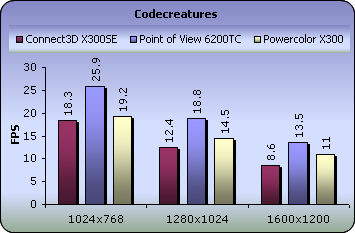
-Codecreatures number
The codecreatures number is the resulting score of the total
benchmarking process and is basically the geometric mean of the three frame
rates multiplied by 100.

In Codecreatures, the 6200TC dominates over the other two X300 cards, without the slightest threat.
8. Aquamark3 / 3DMark 2001
 Since the majority of today's applications and games are compatible with DirectX 9, the need of benchmark applications that use DX 9 has been brought up. The benchmark uses the 3D engine (Krass engine) of the Aquanox game.
Since the majority of today's applications and games are compatible with DirectX 9, the need of benchmark applications that use DX 9 has been brought up. The benchmark uses the 3D engine (Krass engine) of the Aquanox game.
Aquamark Triscore
The Aquamark Triscore comprises 3 values: the overall system performance, the performance of the graphics system and the CPU performance. Keep in mind that this is not the total result of the tests, but the result of the whole benchmark process including all 9 chapters.

3DMark 2001
3DMark 2001 is the predecessor to 3DMark03. It's mainly a directx8.1 benchmark and the score depends a lot on the CPU power of your computer. However for reference use only we decided it'd be best to just leave it in our benchmark list so you can compare the next generation cards with the possibly outdated you have at home.

Both Aquamark and 3DMark01 gave the X300SE a hard time, forcing it to yield the lowest score among the three cards.
9. Half life 2
Half life 2 is no doubt the most anticipated pc game of all times. Gamers keeping the excellence of Half Life 1 in their mind as well as the remarkable E3 demo preview, have been anxiously waiting for the much delayed release of HL2.
 Characters - Advanced facial animation system delivers the most sophisticated in-game characters ever seen. With 40 distinct facial "muscles," human characters convey the full array of human emotion, and respond to the player with fluidity and intelligence.
Characters - Advanced facial animation system delivers the most sophisticated in-game characters ever seen. With 40 distinct facial "muscles," human characters convey the full array of human emotion, and respond to the player with fluidity and intelligence.
Physics - From pebbles to water to 2-ton trucks respond as expected, as they obey the laws of mass, friction, gravity, and buoyancy.
 Graphics
- Source's shader-based renderer, like the one used at Pixar to create movies
such as Toy Story® and Monster's, Inc.®, creates the most beautiful
and realistic environments ever seen in a video game.
Graphics
- Source's shader-based renderer, like the one used at Pixar to create movies
such as Toy Story® and Monster's, Inc.®, creates the most beautiful
and realistic environments ever seen in a video game.
AI - Neither friends nor enemies charge blindly into the fray. They can assess threats, navigate tricky terrain, and fashion weapons from whatever is at hand.
To measure performance we used the Video Stress Test(VST) that is available in the CounterStrike:Source beta available through Steam. We set all the details to the highest level and each time changed the resolution from 800x600 up to 1600x1200.
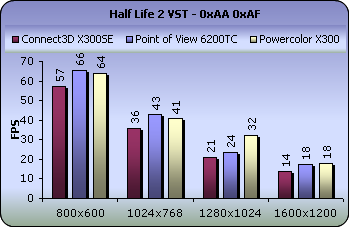
Although you should not expect to play Half Life 2 in full detail at 1024x768 with these cards, you can see the Video Stress Test revealed some pretty decent framerates under that resolution. The 6200TC and X300 are once again on top but not by a large difference.
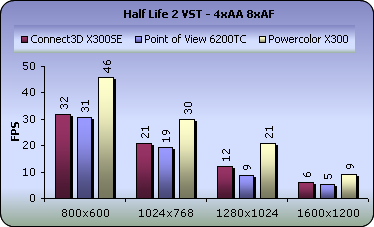
Enabling Anti-Aliasing and Anisotropic-Filtering, forces the 6200TC to drop its performance below the X300SE.
10. Doom 3

A massive demonic invasion has overwhelmed the Union Aerospace Corporations? (UAC) Mars Research Facility leaving only chaos and horror in its wake. As one of the few survivors, you struggle with shock and fear as you fight your way to Hell and back, in an epic clash against pure evil.
Activision made it's miracle again with Doom 3 which is said to be the best-looking game ever, thanks to the brand-new OpenGL graphics engine used to generate its convincingly lifelike, densely atmospheric, and surprisingly expansive environments. If you are a fan of the previous Doom games then you will get many flashbacks with this revision, since you will find reimagined versions of almost every monster from both Doom and Doom II.

To measure performance on the game we used the timedemo demo1 command from the console (Alt+Ctrl+~).
Enabling the high quality setting and executing the timedemo demo1 command twice for each resolution, we witnessed the following:
First, without the Anti-Aliasing and Anisotropic Filtering settings
enabled, we got the following results:

No surprise here. The OpenGL based Doom3 is easier for the 6200TC to render than the two ATi X300 cards. Full detail is once again not worth the performance cost.
11. Far Cry

 You are Jack Carver running your own boat charter business in beautiful Micronesia. With a past best left behind you, you'll be focusing on your present assignment: escorting an ambitious journalist named Valerie Cortez to the Island of Cabatu. It seems like a piece of cake, but you'll soon learn: paradise can be hell.
You are Jack Carver running your own boat charter business in beautiful Micronesia. With a past best left behind you, you'll be focusing on your present assignment: escorting an ambitious journalist named Valerie Cortez to the Island of Cabatu. It seems like a piece of cake, but you'll soon learn: paradise can be hell.
Farcry is an awesome First Person Shooter (FPS) based on a last generation 3D engine named as CryEngine. Real-time editing, bump-mapping, static lights, network system, integrated physics system, shaders, shadows and a dynamic music system are just some of the state of-the-art features that the CryEngine offers.
A great advantage and strong point of the CryEngine is its physics system which supports character inverse kinematics, vehicles, rigid bodies, liquid, rag doll, cloth and body effects. All physics seem to be very realistic and you never get bored when facing enemies, since character models have multiple animations that blend in believable ways.
With an integrated shader system and a massive terrain which maximizes
the view distance to 2km, these features make Farcry a perfect action game and
also a referable benchmark to speak of.
- Benchmark Settings
For this game we recorded a custom demo from the start of the Rebellion
stage. We chose an indoor scene in order to avoid getting the CPU bound effect. This will result in slightly higher results since it is also less
GPU intensive, but we can't afford being stuck at 40-50 fps because of our CPU.

The latest patch (1.3) was used for our tests which updates the
game's graphics engine to use the 3.0 Shader model. This option is only supported
for the 6800 series.
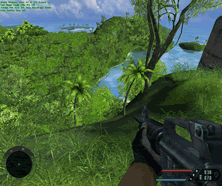
The resolutions we ran the demo under are the following: 800x600,1024x768,
1280x1024 and 1600x1200.

Far cry is another sad story for the X300SE which seems to be justifying some of its witty nicknames. (For the record, SE stands for Standard Edition)
12. Thief 3
 Instead
of Deus Ex from now on we'll be testing our cards using Thief 3. It's based
on the same engine but it's much less GPU intensive and playable by more VGA
cards than
Instead
of Deus Ex from now on we'll be testing our cards using Thief 3. It's based
on the same engine but it's much less GPU intensive and playable by more VGA
cards than  Deus.
Deus.
The game makes severe use of Pixel Shader 1.1 instructions, the bloom effect and stencil shadows to achieve a wonderful result in your screen.
In the game you play the part of Master Thief Garrett who is back to rule out any evil forces using his unique stealth abilities. Deadly Shadows shows what stealth gameplay is all about. This game really gives you the feel of sneaking around and holding your breath when stuck in a sticky situation.
Since there is no official benchmark for the game, we'll do our tests using
a GPU intensive scene from the tutorial-level which we believe that represents
the average fps you'll get when playing the game.
Thief 3 is a torture test for graphics cards. All lower class cards fail to provide stable performance in this benchmark when selecting full details from the settings menu.

Full detail in Thief 3 : Deadly Shadows for these cards is catastrophic. Only the Powercolor managed to get more than 25fps and that's at 640x480 resolution which unfortunately is not acceptable.
13. Colin McRae 05
 For all you racing fans out there, this test is for you and will represent the Racing game category in our benchmarks.
For all you racing fans out there, this test is for you and will represent the Racing game category in our benchmarks.
From the graphics point of view the first thing you'll
notice in the game is the excellent amount detail of your racing car. High
resolution textures on the car and lighting make it quite impressive. All
the eye candy such as the sun reflection in the virtual camera are still the
same as the older CM versions but motion blur has been added when your card
hits something hard which will happen most often if you're new to the racing
simulation world.
To measure performance on the game we used fraps to get the average fps of the whole 8th stage of UK which is actually the only stage you get to play on the demo.
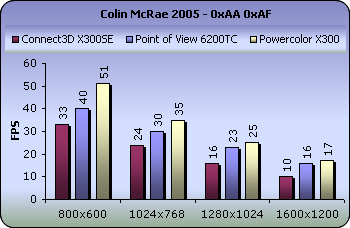
The X300SE managed 24fps under 800x600. However, in order to enjoy the game, you'd either have to spare some of the quality settings to get more decent performance or lower the resolution.

Enabling 4x Anti-Aliasing and 8x Anisotropic Filtering is something you could ignore in this case, as running fast with your car doesn't really give you much time to stop and stare at the game's landscape graphics.

14. Ground Control II
 Ground
Control 2 is an action-oriented game of tactics and warfare. As Captain Jacob
Angelus of the Northern Star Alliance, you will command squads of infantry,
artillery, and air power against the might of the Empire of Terra. Base building
and resource-collecting are replaced with unit control and combat tactics where
your knowledge of the battlefield maneuvers will make the difference in your
fight against a ruthless enemy. Position your troops on hilltops for better
aim or inside buildings and forests for protection as you'll need to use every
inch of terrain to your advantage.
Ground
Control 2 is an action-oriented game of tactics and warfare. As Captain Jacob
Angelus of the Northern Star Alliance, you will command squads of infantry,
artillery, and air power against the might of the Empire of Terra. Base building
and resource-collecting are replaced with unit control and combat tactics where
your knowledge of the battlefield maneuvers will make the difference in your
fight against a ruthless enemy. Position your troops on hilltops for better
aim or inside buildings and forests for protection as you'll need to use every
inch of terrain to your advantage.
For our benchmarks, we used the highest possible settings on the first mission
of the single player game and moved around the camera to get an average frame
rate using fraps.
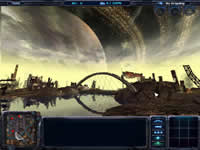
Ground Control II offers really impressive graphics without requiring much GPU power. Click on the picture above to view a screenshot from the game. Check out these excellent water effects!
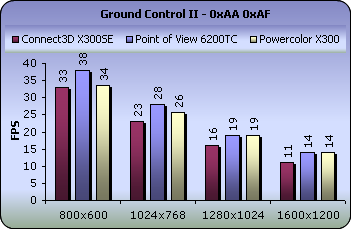
The Point Of View 6200TC starts off with the highest framerate and maintains it up to 1600x1200. The X300SE unfortunately cannot compete with it or the X300 from Powercolor.
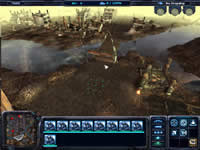
15. Overclocking
No matter your graphics card, there comes a time in your computer's life when it can no longer cope with the latest technology the ever so popular games use. This is one of the main reasons for overclocking your graphics card. Gamers are always looking forward for a little extra boost in terms of framerate. Even though most of the times the boost is far from noticeable, overclocking remains the last resort when you can't afford to buy a brand new VGA card.
 |
Increasing the memory clock too much,
produces the so-called "artifacts". |
The stock clock speeds for the core and memory were 325MHz and 195MHz respectively as you can see in the ATiTool screenshot below. Note that the low quality memory modules from Elixir prevent us from setting the memory clock much higher.

First thing we do to overclock the card is to step-by-step increase the memory clock until we find the maximum stable setting that does not produce screen artifacts in either ATiTool test or the games. Then, being certain of that frequency, we increase the core clock likewise. Our final settings can be seen in the following screenshot.
 |
The overclocking frequencies for the X300SE. |
As you see, the core could be overclocked by another 85MHz. Normally, we'd be excited as 85MHz is quite high, but given the fact the Powercolor X300 could clock up to 500MHz, we can only assume that further overclocking with this card was not possible due to the fanless heatsink.
The Elixir memories were the other factor that let us down in our overclocking effort. The memory clock could only be set to 230MHz without errors. Of course, we shouldn't expect more from such memory modules, otherwise they wouldn't call them 5T would they?
Anyhow, let's see the performance boost we got with the new clock settings:



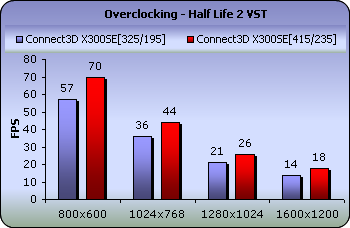
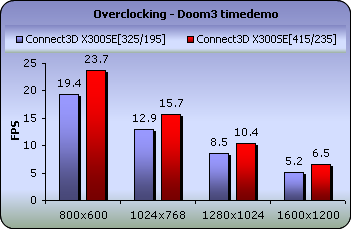
As you can see, the overclocked Connect3D X300SE offers around 22% higher performance than the stock clocked X300SE. Given that, if you overclock the card to these settings, the X300SE can now seriously compete with the 6200TC and X300. However, you can also overclock these cards as well and then, we're back to playing catch up once again.
16. Conclusion
Performance is not a strong point of the Connect3D X300SE. Compared to the POV 6200TC or Powercolor X300 that we have previously reviewed, there's actually quite a large gap between them. In fact, the only thing that makes this card differ from the older 9200 series is the smaller 0.11 micron fabrication process, features like Pixel and Vertex Shader version 2.0 and of course, true DirectX 9.0 support. A nice feature of the X300SE is that unlike the X300, it remains fanless, ensuring zero noise under any circumstances.
Overclocking the X300SE was limited, for two reasons. Firstly, fanless operation and secondly, the memory modules. With a fan cooling the heatsink, the core could be stable at higher frequencies than currently possible without a fan, probably just as high as the Powercolor X300 achieved. However, installing a fan is very easy to do yourself, so that was not as important as the fact that the Elixir memory modules used on the card, are already close to their limits, which proved to be a mere 30MHz higher than the clock frequency.

Listening to user feedback, Connect3D has stripped away any bundled software from their cards in order to keep the costs as low as possible for the end user. This is important, especially for entry level cards such as the X300SE.
The Connect3D X300SE costs around US$60, one of the lowest prices for a DX9 card. Performance is a disadvantage as the card lacks the power to run most modern games with satisfactory framerates or resolutions. However, if a cheap, noiseless card is just what you need for your computer, this card won't disappoint you.
Pros:
- Silent operation
- The cheapest, latest generation card
Cons:
- Not the best performance (as with most SE's)
- No bundled software
Performance/Features: |
|
Overclocking: |
|
Bundle: |
|
Value for money: |
|